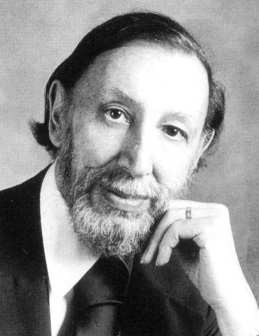Alan Hovhaness
(1911-2000)
 Alan Hovhaness was among the most prolific of 20th century composers. Officially, his catalog is comprised of 67 numbered symphonies and 434 opus numbers. Since many opus numbers comprised two (if not more) separate works, his works actually number well over 500.
Alan Hovhaness was among the most prolific of 20th century composers. Officially, his catalog is comprised of 67 numbered symphonies and 434 opus numbers. Since many opus numbers comprised two (if not more) separate works, his works actually number well over 500.
Hovhaness was born to a Turkish father and American mother in Somerville, Massachusetts. At a young age, the family moved because his mother feared there was a lot of discrimination for people of Armenian descent in that area. Showing an interest in music while he was still a boy, Alan’s first composition came at the age of four, inspired after hearing a Schubert piece. His family showed signs of concern for his well-being and financial stability as an artist, and Alan decided to pursue another passion, astronomy. The fascination never left him, and many works have titles depicting various celestial bodies.
His father took pride in his son’s compositions, and arranged for piano lessons when Alan was younger. Supporting him long into adulthood, even through difficult years, his father remained devoted to seeing his son succeed. From the lineage of Beethoven (Hovhaness studied with Cebhard, who was a student of Theodor Leschetizky, a student of Carl Czerny, who was a pupil of Beethoven’s.) By the tender age of 14, Hovhaness had made the decision to commit his life to composition. One of his most prominent influences was the great Armenian composer Gomidas Vartabed, who had lived through the Armenian Genocide. He composed two operas while still in high school, and studied with Leo Rich Lewis at Tufts following his graduation. Later he studied under Frederick Converse at the New England Conservatory, and won the Samuel Endicott prize for composition in 1932. Hovhaness traveled with his first wife (he married six times) to Finland in 1934 to meet the composer Jean Sibelius, an inspirational figure since childhood. Following the meeting, the two would remain in correspondence for the next 20 years, and Sibelius was named godfather of his only child, Jean Christina Hovhaness.
During the 1930s and 1940s, Hovhaness famously destroyed many of his early works, with estimates of 500-1000 works being lost. In an interview, he stated that the decision was based primarily on Roger Sessions' criticism of his works of that period, and that he wished to have a new start in his composing. In the mid-1940s, the “Friends of Armenian Music Committee” (led by several of Hovhaness’s friends) sponsored several high-profile concerts of his music, which considerably raised his popularity in the New York area. With their help, much of Alan’s music was recorded and appeared on MGM and Mercury records in the 1950s, which solidified his place in American music forever.
Over the next several years, Hovhaness participated in several different musical venues. He joined the faculty of the Boston Conservatory in 1948 and taught until 1951. When he left the Conservatory, he moved to New York City, to pursue composing full-time. Simultaneously, he worked at the Voice of America, the external broadcast institution of the United States federal government. However, he lost this position when Dwight D. Eisenhower succeeded Harry S. Truman as President in 1953. Following this position, he received 2 Guggenheim fellowships in composition, and began writing scores for plays, ballets, and documentaries. Hovhaness received his biggest breakthrough in 1955, when the Houston Symphony premiered his Symphony No. 2, Mysterious Mountain, under Leopold Stokowski. Under the urging of Howard Hanson, he then taught 3 summers at the Eastman School of Music.
Hovhaness conducted several research trips to investigate ancient music traditions of different countries and eventually began implementing these native themes and ideas into his own pieces. Locations included South Korea, India, Hawaii, Japan, Russia, Switzerland and Armenia (the only time he ever visited his homeland).
He moved to Seattle in the early 1970s, where he would remain for the rest of his life. In 1973, he composed his third and final ballet score for Martha Graham. Over the next 20 years, he wrote approximately three dozen symphonies.
By 1996 his good health had started to decline. He spent three years in intensive care, and died on June 21, 2000 from a long-term stomach ailment. Hovhaness is survived by his wife, the coloratura soprano Hinako Fujihara Hovhaness, as well as his daughter Jean, a harpsichordist.
Click below to view Alan Hovhaness titles:
t7t3l0uhl8|0010C39D6D07|DetailContent|contenttext|DD4A9680-60C1-4589-80E7-24D9673073E6
<